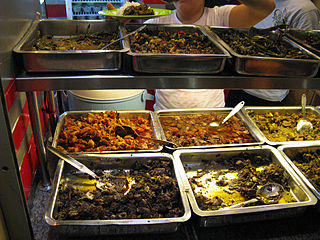
Indonesian cuisine is a collection of various regional culinary traditions that formed the archipelagic nation of Indonesia. There are a wide variety of recipes and cuisines in part because Indonesia is composed of approximately 6,000 populated islands of the total 17,508 in the world's largest archipelago, with more than 1,300 ethnic groups.

Tuna casserole is a casserole primarily made with pasta or rice and canned tuna, with peas sometimes added. The dish is often topped with potato chips, corn flakes, bread crumbs or canned fried onions. Tuna casserole is a common dish in some parts of the United States, often prepared using only nonperishable pantry ingredients.

Talempong is a traditional music of the Minangkabau people of Western Sumatra, Indonesia. The talempong produce a static texture consisting of interlocking rhythms.

Gorontalo is a city and the capital of the Gorontalo Province, Indonesia. It is on the island of Sulawesi. The city has an area of 79.59 km2 and had a population of 179,991 at the 2010 census and 198,539 at the 2020 census; the official estimate as at mid 2021 was 199,788.

Javanese cuisine is the cuisine of Javanese people, a major ethnic group in Indonesia, more precisely the province of Central Java, Yogyakarta and East Java.

Bakwan is a vegetable fritter or gorengan that are commonly found in Indonesia. Bakwan are usually sold by traveling street vendors. The ingredients are vegetables; usually beansprouts, shredded cabbages and carrots, battered and deep fried in cooking oil. To achieve crispy texture, the batter uses a mixture of flour, corn starch and sago or tapioca. In West Java bakwan is known as bala-bala and in Semarang is called badak. It is similar to Japanese yasai tenpura, Korean pajeon, Burmese A-kyaw or Filipino ukoy.

Mie koclok, is an Indonesian chicken noodle soup, a specialty of Cirebon city, West Java. The noodles come with a white-colored extra-thick porridge-like soup, made of chicken broth and coconut milk soup, which is coagulated with corn starch or tapioca. Other ingredients include shredded chicken breast, cabbage, bean sprouts, hard boiled egg, kaffir lime juice, and sprinkled with sliced fresh celery, spring onion, and fried shallot.

Minahasan cuisine or Manado cuisine is the cooking tradition of the Minahasan people of North Sulawesi, Indonesia. It is popularly known as "Manadonese cuisine" after Manado, the capital of the province, although other cities in Northern Sulawesi, such as Bitung, Tomohon and Tondano, are also known as Minahasan culinary hotspots. Manadonese cuisine is known for its rich variations in seafood, generous amount of spices, extra-hot condiments, exotic meats, and European-influenced cakes and pastries. Popular Manadonese dishes include tinutuan, cakalang fufu, cakalang noodle, paniki, chicken or various fish and seafood spiced in rica-rica or woku spices, chicken tuturuga, and brenebon.

Rica-rica is a type of Southeast Asian hot and spicy bumbu found in Minahasan cuisine and Gorontalo cuisine of Minahasa Peninsula, North Sulawesi, Indonesia.

Asam pedas is a Maritime Southeast Asian sour and spicy fish stew dish. Asam pedas is believed to come from Minangkabau cuisine of West Sumatra, Indonesia and has spread throughout to the islands of Sumatra, Borneo and Malay Peninsula.

Mie cakalang is a traditional Indonesian skipjack tuna noodle soup from Manado, North Sulawesi, Indonesia. Mie means "noodle", while cakalang is Manado dialect for "skipjack tuna".

Indian Indonesian cuisine is characterized by the mixture of Indian cuisine with local Indonesian-style. This cuisine consists of adaptations of authentic dishes from India, as well as original creations inspired by the diverse food culture of Indonesia. Indian influence can be observed in Indonesia as early as the 4th century. Following the spread of Islam to Indonesia and trading, Muslim Indian as well as Arab influences made their way into Indonesian cuisine. Examples include Indian biryani, murtabak, curry and paratha that influenced Acehnese, Minangkabau, Malay, Palembangese, Betawi and Javanese cuisine.

Indonesian noodles are a significant aspect of Indonesian cuisine which is itself very diverse. Indonesian cuisine recognizes many types of noodles, with each region of the country often developing its own distinct recipes.

The bening is a traditional baby carrier used by the Dayak people, especially the Dayak Kenyah in Bulungan Regency, North Kalimantan. It is made of carved wood and decorated with colorful wickers and beads, and sometimes also with metal currencies. Variations of images in the carved wood were based on the user's position on society. Images such as tiger and human face motifs indicate that the user is a member of the aristocracy or a noble family, while a plain bening without any decoration indicates the user is a commoner.

Gorontalese cuisine or Gorontalo cuisine is a genuine cuisine and taste of the Gorontalese People of Gorontalo Peninsula, Northern part of Sulawesi island, Indonesia. It is also known as Hulontalo cuisine by perantauan (migrating) Gorontalo people after "Hulontalo", the local language name for Gorontalo.

Sate tuna or tuna satay, also commonly referred as Gorontalesetuna satay is a speciality satay, originally from Gorontalese cuisine, Sulawesi island, Indonesia.



















